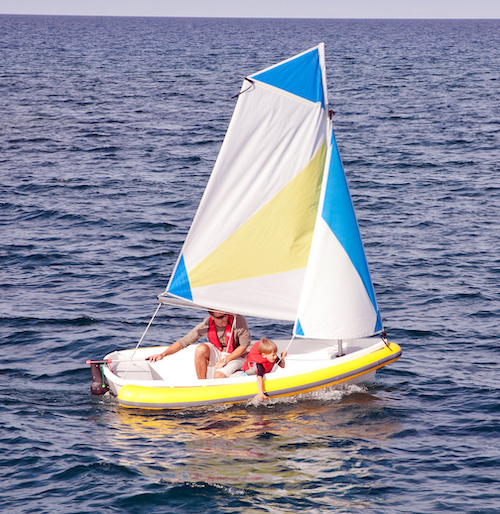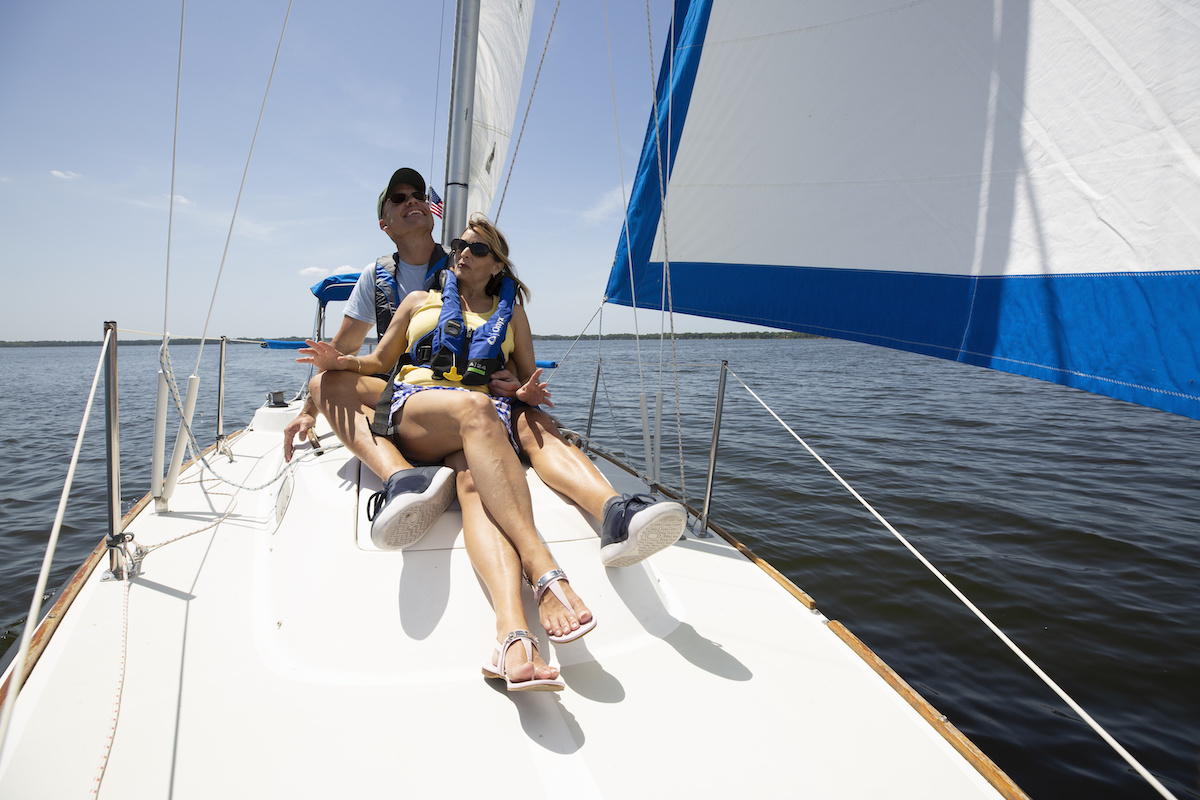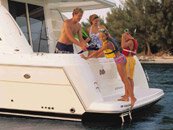There’s something special about sailing: harnessing the power of the wind and bending it to move boat and crew across the water. Sailing does, however, bring some special safety considerations. It’s arguably easier to find yourself in the water on a sailing adventure than in most other boating settings. In a larger sailboat, you could tumble over the side while hiking out—leaning out over the boat to help counter its tilt and thus maximize speed—and there’s always that boom threatening to clear the decks of inattentive sailors.
Regardless of the size of the sailboat you're on, here's a few safety tips to keep in mind.
 Sailing Harness & Life Jackets
Sailing Harness & Life Jackets
A hiking strap or harness can help avoid the falling into the water, and caution can help you avoid the boom. Every crew member or passenger onboard a sailboat should wear life jackets; one can save your life, but only if you’re wearing it. New life jacket models are far more comfortable than those of old, and some even come with a safety harness and tether built-in, ready to clip to a jackline along the gunwales of an offshore sailboat.
Learn more by reading Life Jackets, Vests & PFDs: How to Choose the Right Fit.
Capsizing Considerations
Smaller sailboats, the kind that give most sailors their first rides and remain for many the craft of choice, add capsizing to the risk. Keelboats have heavy weights at the end of long, fixed underwater fins; they steady boats in all but the most severe situations. Smaller sailboats have centerboards or daggerboards that help the boat track well but don’t do much to keep it upright. In one of them, there’s bound to be a time when your boat is “knocked down” by a sudden wind blast or a crew miscue.
Take a course—or study—and practice rerighting the boat by using the centerboard or daggerboard as a lever. Then when the boat goes over, in practically no time you’ll be trimming the sails and resuming your voyage.
Learn more in Sailing Capsize Recovery: Scoop & Single-Handed Methods.
Special Safety Tips for Sailors
Response Time
Sailboats just can’t respond as quickly as most powerboats. That means planning turns and other maneuvers a bit more deliberately. Learn and practice crew-overboard procedures; above all make certain in a crew-overboard situation that one person keeps in sight, and points at, the person in the water while the captain brings the boat about. And when winds are especially fast, you’ll be glad if you took a course that includes adjusting sails in the face of a storm (US Sailing trains instructors and schedules Safety at Sea classes on all kinds of sailing and how to go about learning to sail).
Grounding & Weather
The relatively deep drafts of sailboats, thanks to keel fins and center- and daggerboards, means extra attention is needed to avoid grounding. Weather is always a consideration to a boater, but a weather eye is even more important to a sailor, who can’t pick up and run from storms as can one in a power boat.

When All Seems Wrong, Take a Deep Breath
Sometimes, in the frantic practice of sailing, a sailor simply needs to stop everything, pause and recompose. That seems impossible when the wind’s blowing. In his book, “Learn to Sail,” legendary sailor Dennis Conner prescribes a “time-out position,” in which one releases the sheets of the mainsail and headsail—if so equipped—while the wind is at right angles to the boat’s centerline. When the boat has stopped, aim the tiller at the sails to release pressure on the rudder. You’ve effectively taken your foot off the gas and the “car” out of gear. Take a cleansing breath, figure things out, then return the helm to parallel with the centerline, trim (snug up) first the headsail then the mainsail, and you’re back on the “road!”
When the Wind Stops
Sometimes, winds will fall or equipment will fail, and your movement ends. Plan for it: how will you get back to port or land? Larger boats might have an auxiliary inboard or outboard motor. For small boats and sailboards, a paddle might be the best bet. At the very least, make sure you have a phone or radio on which you can hail assistance if needed.
Additional Safety Gear
Beyond life jackets, other accessories can make sailing safer:
- Safety glasses guard eyes against loose tackle
- UV-blocking sunglasses protect eyes further
- SPF-rated clothing and sunscreen cloak skin from the sun
- Fingerless nylon- or leather-faced sailing gloves make handling lines and cables easier and gentler
- An Automatic Identification System receiver can keep you posted on the paths of large ships and commercial passenger vessels so that you have extra time to avoid them.
Don't Forget to File a Float Plan
In writing, tell someone whose judgment you trust:
- Where you’re going;
- What your boat—and tow vehicle, if trailering—look like;
- Include sail numbers or logos;
- When you plan to return;
- When authorities should be called if you’re late.
While sailing does require special attention to weather, water conditions, riggings and responses, those things all enrich the experience of riding on the wind!
Read Next: General Boating Safety Guide
You Might Also Like:
- Best Small Sailboats for Beginners
- Types of Sailboats, Activities & Uses
- Buying a Sailboat: Factors to Consider
- Learning the Basics of Sailing
- Explore Sailboat Brands


